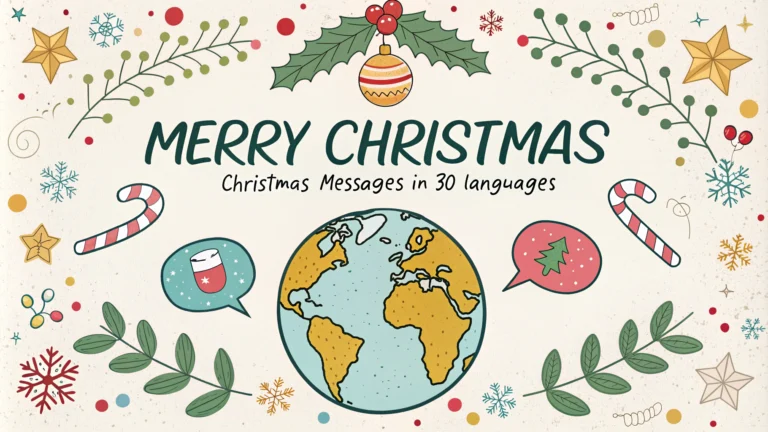Sending holiday wishes in different languages adds a personal touch and shows cultural appreciation during the festive season.
Popular Christmas Greetings in Major Languages
- English: “Merry Christmas!”
- Spanish: “¡Feliz Navidad!”
- French: “Joyeux Noël!”
- German: “Frohe Weihnachten!”
- Italian: “Buon Natale!”
Asian Christmas Greetings
- Japanese: “メリークリスマス” (Meri Kurisumasu)
- Chinese: “圣诞快乐” (Shèngdàn kuàilè)
- Korean: “메리 크리스마스” (Meri Keuriseumaseu)
- Vietnamese: “Chúc Mừng Giáng Sinh”
- Thai: “สุขสันต์วันคริสต์มาส” (Suk san wan Christmas)
European Christmas Greetings
- Dutch: “Prettige Kerstdagen!”
- Portuguese: “Feliz Natal!”
- Greek: “Καλά Χριστούγεννα!” (Kala Christougenna)
- Russian: “С Рождеством!” (S Rozhdestvom)
- Swedish: “God Jul!”
Tips for Using Christmas Greetings
- Check the pronunciation before using the greeting in person
- Consider regional variations within languages
- Include both the original script and romanized version when writing
- Learn one or two common responses in each language
Additional Holiday Phrases
| Language | Happy New Year | Season’s Greetings |
|---|---|---|
| English | Happy New Year | Season’s Greetings |
| Spanish | Feliz Año Nuevo | Felices Fiestas |
| French | Bonne Année | Meilleurs Vœux |
Remember to respect local customs and traditions when using these greetings.
Consider time zones when sending international Christmas messages to ensure they arrive at an appropriate time.
Resources for Learning Pronunciations
- Forvo – User-submitted pronunciations
- Google Translate – Audio pronunciations available
- Duolingo – Free language learning with holiday-specific lessons
Cultural Context and Timing
- Different cultures celebrate Christmas on different dates
- Orthodox Christmas is celebrated on January 7th
- Some countries exchange gifts on December 6th (St. Nicholas Day)
- Consider religious sensitivities in different regions
Digital Greeting Etiquette
- Use appropriate fonts that support multiple character sets
- Include translations for international recipients
- Consider using imagery that’s culturally relevant
- Avoid automatic translation tools without verification
Business Communication During Holidays
Professional Greetings
- Keep messages formal when appropriate
- Include both local and recipient’s traditional greetings
- Consider company policy on religious expressions
- Maintain professional tone while being festive
Conclusion
Learning holiday greetings in different languages demonstrates respect for cultural diversity and helps build stronger international relationships. Whether for personal or professional use, taking the time to learn these expressions can make holiday communications more meaningful and inclusive.
Remember to:
- Practice pronunciation beforehand
- Be mindful of cultural differences
- Use appropriate timing for different celebrations
- Keep records of greetings for future reference
FAQs
1. How do you say “Merry Christmas” in Spanish and French?
In Spanish, it’s “Feliz Navidad” and in French, it’s “Joyeux Noël.”
2. Which Asian languages have the most unique Christmas greetings?
In Japanese, it’s “Meri Kurisumasu” (メリークリスマス), in Korean “Meri Krismas” (메리 크리스마스), and in Mandarin Chinese “Sheng Dan Kuai Le” (圣诞快乐).
3. What are some traditional German Christmas greetings?
The most common are “Frohe Weihnachten” and “Fröhliche Weihnachten,” while “Gesegnete Weihnachten” means “Blessed Christmas.”
4. How do Scandinavian countries say Merry Christmas?
In Swedish it’s “God Jul,” in Norwegian “God Jul,” and in Danish “Glædelig Jul.”
5. What’s the traditional Christmas greeting in Italian?
“Buon Natale” is the standard Italian Christmas greeting, while “Felice Natale” is also commonly used.
6. How do you write Christmas greetings in Russian?
In Russian, it’s “S Rozhdestvom” (С Рождеством), written in Cyrillic script.
7. What’s the difference between Greek and Arabic Christmas greetings?
In Greek, it’s “Kala Christougenna” (Καλά Χριστούγεννα), while in Arabic it’s “Eid Milad Majid” (عيد ميلاد مجيد).
8. How do Polish people express Christmas wishes?
The traditional Polish greeting is “Wesołych Świąt,” often followed by “Bożego Narodzenia.”
9. What are the Christmas greetings in Celtic languages?
In Irish Gaelic, it’s “Nollaig Shona Duit,” in Scottish Gaelic “Nollaig Chridheil,” and in Welsh “Nadolig Llawen.”
10. How do you say Merry Christmas in Portuguese variants?
In European Portuguese, it’s “Feliz Natal,” which is the same in Brazilian Portuguese, though pronunciation differs slightly.







